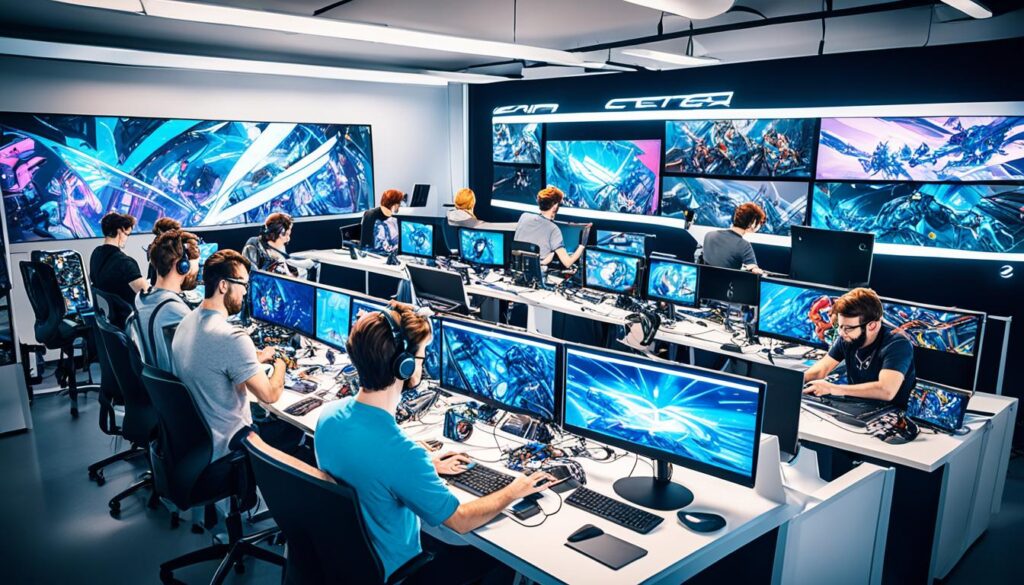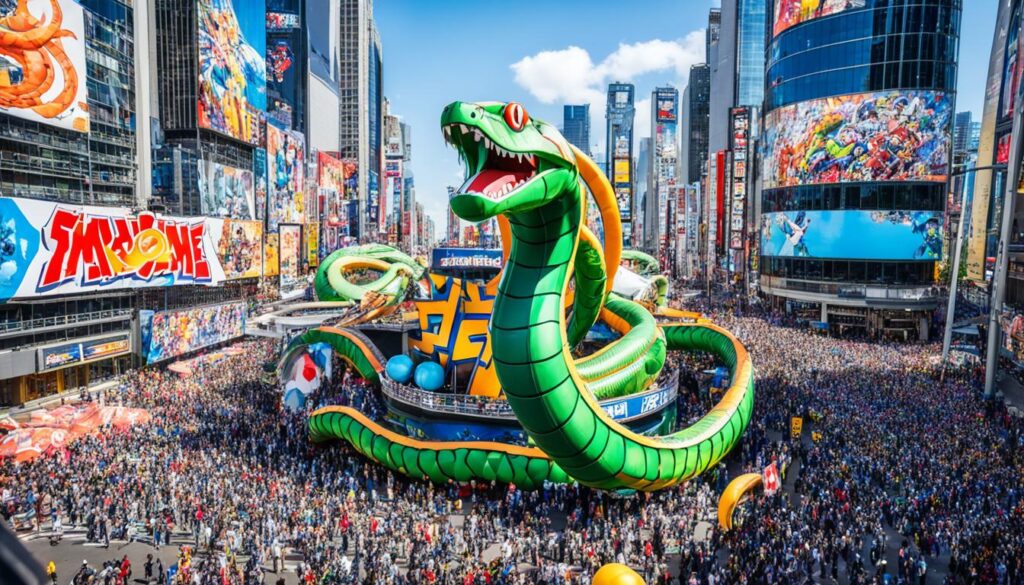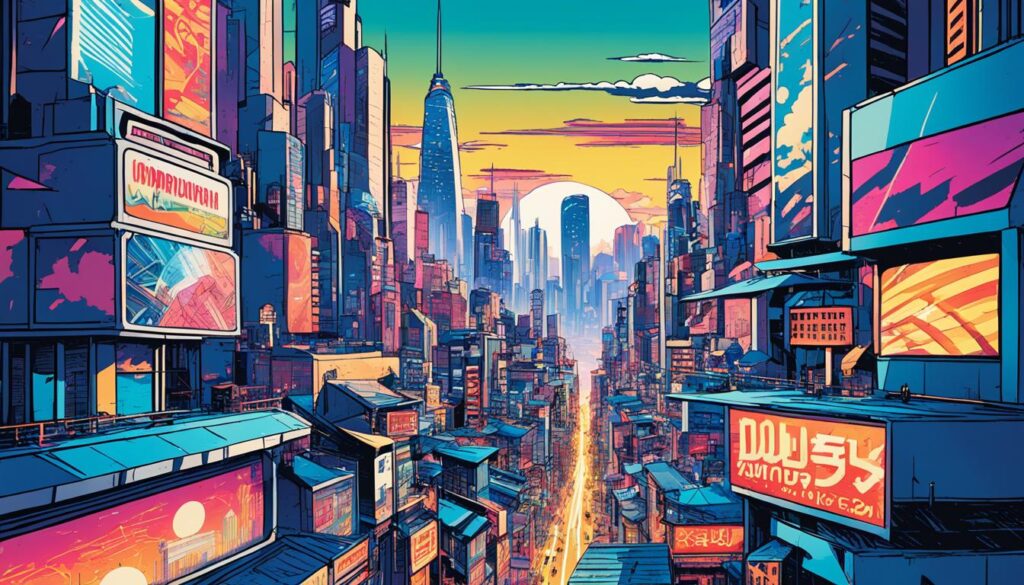Manga, the iconic Japanese comics, hit record sales of ¥677 billion in 2022. Anime, its animated form, has also seen a huge rise in fans. This shows how much people around the world love these Japanese stories.
These stories are now spreading more than ever, thanks to new technology. It’s an exciting time for anime and manga. They bring together art, new ideas, and rich cultural stories, making people everywhere fall in love with them.
Key Takeaways
- The global popularity of anime and manga is soaring, with record-breaking sales figures showcasing their widespread appeal.
- New digital platforms and technologies are transforming the landscape of anime and manga, enabling creators to push the boundaries of storytelling.
- Anime and manga are deeply rooted in Japanese culture, but their universal appeal has transcended borders, captivating audiences worldwide.
- The future of these art forms looks promising, with creators and industry professionals embracing innovations to ensure their continued growth and impact.
- Preserving the unique cultural identity and artistic integrity of anime and manga is a critical concern as the industry evolves.
The Global Reach of Japanese Pop Culture
Anime comes from the word “animation”. It has become a hit around the world. It draws people in with its special stories and bright art. Manga, or “whimsical pictures,” are Japanese comic books and novels. They also have fans around the globe. These arts are from Japan but are loved everywhere, making a big mark on world culture.
Anime’s Rising Popularity
Anime is a unique style of animated tale from Japan. It has won the hearts of many viewers with its stories and art. It’s now a big part of Japanese pop culture, known around the earth. The stunning visuals and captivating tales have helped it spread far from Japan.
Manga’s Worldwide Success
Manga, the Japanese term for comic books and novels, is taking over new places. It’s part of why Japanese pop culture is so big in entertainment. Its beautiful art attracts readers from all cultures. This helps build connections across the globe.
The Professionals Behind the Scenes
The anime and manga worlds owe their beauty to many talented people in Japan. They include creators, illustrators, authors, and others. Their hard work helps these stories and characters come alive for fans around the globe.
Creators and Animators
Leading the creation process are the minds behind anime. This includes the directors and producers. They use advanced tools to make each moment in an anime perfect. This way, the shows we love are born.
Illustrators and Authors
In manga, illustrators and authors, known as “mangaka,” play a key role. They design and write stories in a way that’s hard to put down. With help from their teams, they create the manga that fans can’t wait to read.
Voice Actors and Cosplay Communities
The heart of anime beats with the voice actors. They give characters their voices and emotions. Cosplay fans play a big role too. They dress up like their favorite characters, showing their love for the series.
Everyone in the industry works hard to make anime and manga amazing. This includes animators, illustrators, and even those who perform the voices. These dedicated people help bring unforgettable stories to life.

The Impact of New Billing and Tax Systems
In 2023, many professionals from Japan’s culture scene, like freelancers and artists in the anime and manga industry, joined together. They voiced their concerns about a new billing and tax collection system called ‘Invoice,’ which Japan began using last October. People affected include freelancers worried they might have to charge more or earn less, seeing this as a hidden tax increase. These self-employed artists worry a lot about how this new system will affect their livelihoods and working conditions.
Many in the creative world now feel more anxious. They worry about what this new billing and tax system might do to their earnings and creative work. The thought of more paperwork and less money is making an already tough situation worse for them.
The anime and manga industry keeps growing and changing. The concerns of these freelancers and self-employed artists highlight a big problem. They’re pushing for leaders and government folks to better understand and fix the issues with billing and tax systems. These systems directly affect the livelihoods of those creating these admired art pieces.
The Booming Profits in the Industry
The anime and manga business has its share of challenges. Despite this, it’s making big money. In 2022, the anime world alone made ¥2.74 trillion. That’s around €175 billion, or US$194 billion. These numbers have been climbing since 2010. A report by the Association of Japanese Animations shows this. The success shows how important anime has become globally.
Anime’s Record Revenue
Many things are behind the anime industry’s success. One big reason is its worldwide appeal. People everywhere love Japanese animation. This has been a huge part of its financial wins. Plus, the industry keeps up with new tech and what viewers want to see. These factors are key to its growth.
Manga’s Soaring Sales
As anime soars, manga doesn’t fall behind. It’s selling more than ever. In 2022, sales hit ¥677 billion. That’s around €4.3 billion, or US$4.8 billion. It shows how much people around the world love Japanese comics. They keep inspiring new readers.
These successes in anime and manga point to their growing impact. The future looks bright as they face and overcome challenges. The embrace of new tech shows their potential for even more success. They’re becoming bigger parts of our global entertainment scene.
The Booming Profits in the Industry
Despite the challenges faced by the professionals in the anime and manga industry, profits are booming. In 2022, the anime industry alone generated ¥2.74 trillion (around €175 billion, US$194 billion), record figures that have been on the rise since 2010, according to a report by the Association of Japanese Animations. This remarkable performance highlights the growing popularity and economic significance of the anime industry.
Anime’s Record Revenue
The surge in anime industry profits can be attributed to various factors, including the global reach of Japanese animation and the increasing demand for high-quality, innovative content. Anime’s ability to captivate audiences worldwide, transcending cultural boundaries, has been a key driver of its financial success. The industry’s ability to adapt to new technologies and evolving viewer preferences has also played a crucial role in its continued growth.
Manga’s Soaring Sales
Alongside the anime industry’s impressive performance, the manga industry has also seen a remarkable rise in sales. In 2022, manga comic books and magazine sales reached a record ¥677 billion (around €4.3 billion, US$4.8 billion), indicating the continued growth and success of the manga industry. This surge in manga sales reflects the enduring appeal of Japanese graphic storytelling, which has found a global audience and continues to inspire new generations of readers.
The booming profits in the anime and manga industry underscore the significant economic growth and cultural impact of these beloved art forms. As the industry navigates challenges and embraces new technologies, the future of anime and manga remains bright, with the potential for even greater success and influence in the global entertainment landscape.

Organizing and New Trade Union Strategies
In Japan, animation professionals are facing tough times. However, they are coming together to tackle these issues. A new group, the Nippon Anime & Film Culture Association (NAFCA), has started. It was created by people who want to protect the nation’s art. Their goal is to form a strong community, demand important resources and policies, improve worker’s rights, and protect the culture of anime and manga.
The Nippon Anime & Film Culture Association (NAFCA)
The NAFCA is not afraid to point out the bad work conditions animators deal with. These problems have made the industry rely more on work from outside Japan. This shift puts the future of the industry at risk. The group pushes for better policies and more support, especially for freelancers in anime and manga.
Advocacy for Better Working Conditions
The NAFCA is making efforts to better the lives of animators. They want fair pay, realistic deadlines, and benefits like healthcare. By working together, the group believes they can make a significant impact. They aim to fight for changes that will make the industry stronger and support the growth of Japan’s art.
Future Challenges in the Anime Industry
The anime world faces many challenges today. Offshoring, the trend of moving animation production overseas, is a big concern. It brings worries about quality drop and loss of local creativity and know-how. If offshoring keeps going, it may cut jobs in Japan, deprive young talent of training, and threaten the soul of Japanese anime.
Offshoring and Quality Concerns
Anime creation being outsourced to cut costs has made waves. It might mean lower quality shows. With fewer local artists and experts, anime risks losing its unique cultural flair and creative strength. It’s key to keep anime’s special look and stories alive as the industry spreads globally.
Preserving Cultural Identity
Keeping anime’s cultural and creative heart safe is crucial. Anime stands out with its unique look, deep stories, and Japanese roots. But, offshoring could wash away these essential features. The industry must find ways to keep anime true to its Japanese essence. This way, it can still charm audiences around the world.

The Evolution of Anime and Manga Storytelling
The history of anime and manga is full of creative stories and skillful art. It started with animators like Jun’ichi Kouchi using hand-drawn methods. This set the stage for advanced animation later on. The world of anime and manga has grown a lot. Now, creators use digital tools to tell complex stories and explore new themes. This journey has shown that these art forms are for everyone, not just kids.
From Traditional Hand-drawn Techniques to Digital Innovations
“Katsudō Shashin,” made by Shimokawa Oten in 1907, was Japan’s first animated film. It showed how powerful animation could be for telling stories. Through the years, pioneers like Jun’ichi Kouchi and films like “Momotaro’s Divine Sea Warriors” by Mitsuyo Seo showed how animation evolved. It became a way to entertain and bring people together.
With time, the worlds of anime and manga welcomed digital innovation. This allowed for more creative stories and deeper themes. The birth of “Astro Boy” in 1963 by Osamu Tezuka changed everything. It explored ideas like artificial intelligence and ethics, making a mark on both manga and anime.
Exploring Complex Themes and Genres
Anime and manga have grown beyond just for kids, touching on deep themes and genres. Studios like Studio Ghibli, led by Hayao Miyazaki and Isao Takahata, have made films such as “My Neighbor Totoro” and “Spirited Away.” These works show the beauty and depth of Japanese animation to the whole world.
Traditional Japanese art, like Katsushika Hokusai’s, inspired manga too. His scenes of everyday life and emotions became a base for the manga storytelling we see today.
Cultural Significance and Influence
Anime and manga are now a big part of Japanese life. They affect entertainment, fashion, and tech. In Japan, people of all ages love these art forms. You see anime stuff everywhere and theme cafes are common. Around the world, anime and manga are super popular. They have truly changed global culture.
Anime and Manga in Japanese Society
Anime and manga are more than stories in Japan. They are woven into the culture. With famous creators like Osamu Tezuka and Studio Ghibli, these art forms make Japan proud. They show Japan’s creative side and its unique stories.
Global Impact and Appreciation
Anime and manga have fans everywhere. They introduce the world to Japan’s animation and stories. Shows like “Dragon Ball” and “Attack on Titan” are loved by many. And people are discovering manga’s beauty and creativity through translations.

| Statistic | Value |
|---|---|
| Prevalence of schizophrenia worldwide | About 1 percent of the population |
| Lifetime prevalence rates of bipolar disorder | 0.3-1.5% |
| Lifetime prevalence rates of panic disorder | 0.4-2.9% |
The Future of Anime and Manga
Anime and manga are becoming more and more popular. With new animation methods and broader storytelling horizons, they offer exciting prospects. Artists and animators are using digital tools for more creative work. This allows them to tackle deep themes and genres. The industry’s knack for adopting new technologies and enhancing story capabilities is key. It ensures anime and manga stay beloved and relevant as their journey continues.
Technological Advancements in Animation
The anime and manga fields shine in technological advancements. They are always striving to improve animation. With digital tools, creators make stories more visually engaging. From smooth character actions to stunning backgrounds, animation advancements change how fans interact with their favorite worlds.
Expanding Storytelling Horizons
Anime and manga makers are finding fresh, creative ways to charm their viewers. By introducing new themes and genres, manga pioneers like Gege Akutami are leading the charge. These innovative steps promise exciting tales. Whether deep character explorations or stories that break genres, the future here is limitless.
A Glimpse into the World of a Manga Creator
Manga creators, like some others in the artist world, keep their lives secret. This includes not telling anyone their gender. But, Soushi Tory, a well-known manga creator, did talk about how they make manga.
They said the move to digital platforms changed a lot. Now, they’re less tied to making deadlines for print.
The Creative Process
Tory talked about how manga artists are doing things differently today, especially with digital platforms. They’re still all about thorough research and telling great stories. The world of manga even has its very own type of story. It’s called “mangaka manga.”
These stories mix real life and fiction about the lives of these hardworking creators.
Transitioning to Digital Platforms
Creators in the manga world are figuring out how to use the internet for publishing. This means they’re changing how they work to fit this new way of doing things. The switch to digital has opened lots of new doors. Creators can now try new things and grab more attention from fans. This is changing the manga world in big ways.

The Influence of Traditional Japanese Art
To fully grasp manga’s way of telling stories, we should look at how traditional Japanese art has influenced it. A key figure here is Katsushika Hokusai with his “Hokusai Manga” from 1814-1834. This work showed daily life and a wide range of subjects with a focus on realism and human emotions. His traditional Japanese art techniques have inspired artists who create manga today. This link between traditional and modern art is important in the world of manga.
Katsushika Hokusai’s Legacy
Hokusai’s amazing work, such as “The Great Wave off Kanagawa,” has greatly shaped anime and manga. He was known for showing movement and attention to detail, making his art lively and realistic. Today’s manga creators often use Hokusai’s unique style in their art. This mix of old and new in visual storytelling is a big part of what makes manga special.
Conclusion
The history of anime and manga is rich with creativity and art. It started small but now touches many around the world. The love for anime and manga keeps growing. This shows how much people enjoy stories told through art.
The future looks bright with new tech and more diverse stories. The anime market was worth about $24.23 billion in 2021. The manga industry made around $5.85 billion in Japan in 2020. These numbers show the importance of keeping up with change and coming up with new ideas.
Anime and manga have changed the world with their creativity. Their influence is spreading far and wide, winning over hearts everywhere. They are now a big part of Japan’s pop culture scene and are here to stay.
FAQ
What is the global reach of Japanese pop culture?
Japanese pop culture, including anime and manga, has fans from all over the world. Anime stories, animated in a unique style, have grown in popularity. Manga, or Japanese comic books, are also reaching new readers globally.
Who are the professionals behind the anime and manga industry?
A diverse range of experts work in Japan’s entertainment sector. This includes creators of anime and video games, along with those who direct and produce. Others include illustrators and manga authors, their helpers, and publishers. Voice actors, cosplay promoters, and digital device makers also play a big role.
How have new billing and tax systems impacted the industry?
In 2023, Japan’s culture pros protested against a new billing and tax system. This hurt freelancers, making them think their pay will drop. They believe it’s like a hidden tax increase. These changes concern those working in anime and manga, affecting their earnings and work life.
What is the current state of the anime and manga industry’s profits?
Even facing challenges, the industry is making more money. In 2022, anime brought in ¥2.74 trillion, setting a record since 2010. Manga sales also hit an all-time high of ¥677 billion in 2022. This growth shows the strength and success of both sectors.
How are professionals in the industry organizing to address their concerns?
Worried about the future, animation experts formed the Nippon Anime & Film Culture Association. This group wants to improve conditions and rights for creators. They aim to stop the decrease in local animation work by pushing for better policies and support networks.
What are the future challenges facing the anime industry?
The anime industry is battling several issues that could harm its future. One problem is more animation work going overseas, leading to quality concerns. If not solved, Japan might lose the unique facets of its anime. Solutions are being sought to protect the art and keep it thriving worldwide.
How have anime and manga evolved in terms of storytelling and artistic techniques?
Anime and manga have a long history of changing and innovating. Old masters, like Jun’ichi Kouchi, used to draw everything by hand. Now, artists use digital tools and tackle complex stories. This journey blends tradition with new technology.
What is the cultural significance and influence of anime and manga?
Anime and manga are not just stories; they are part of Japan’s culture. They influence fashion, technology, and entertainment, even outside of Japan. The world is captivated by their stories, leading to a global fanbase.
What is the future outlook for anime and manga?
The future of anime and manga is bright, thanks to new tech and story approaches. Artists are using more digital tools, bringing new stories to life. Their ability to adapt and grow will keep anime and manga as beloved cultural icons for many years to come.
How do manga creators approach their craft?
Manga creators, or mangakas, are known for their private lives. Soushi Tory, a mangaka, talks about moving from print to digital for more flexibility. This change hasn’t lessened the craft’s attention to detail and storytelling. Tory’s approach shows how artists adapt to new and changing environments.
How have traditional Japanese art forms influenced anime and manga?
To really get manga’s visual style, we must look at traditional Japanese art, like Hokusai’s work. Hokusai’s “Hokusai Manga” showed diverse daily life scenes with realism. Contemporary manga takes inspiration, blending traditional and new storytelling and art.
Source Links
- https://forums.tapas.io/t/your-thoughts-on-the-future-of-webcomics-and-manga/46401
- https://worstgen.alwaysdata.net/forum/threads/what-are-your-wishes-for-the-future-of-the-manga-industry.45263/
- https://mangahelpers.com/forum/threads/the-present-and-future-of-the-us-anime-industry.75172/latest
- https://en.wikipedia.org/wiki/Japanese_popular_culture
- https://medium.com/@hollaghost123/getting-to-know-japanese-pop-culture-16a2e2b76334
- https://aicontentfy.com/en/blog/seo-job-outlook-promising-future-for-seo-professionals
- https://www.nwhealth.edu/news/business-insider-healthcare-professionals/
- https://clarencebrowntheatre.com/
- https://www.brookings.edu/articles/the-coming-fiscal-cliff-a-blueprint-for-tax-reform-in-2025/
- https://tax.thomsonreuters.com/blog/exploring-key-2024-tax-bill-proposals/
- https://tax.thomsonreuters.com/blog/exploring-the-future-of-tax-automation-how-to-elevate-your-firms-efficiency-and-accuracy/
- https://www.forbes.com/advisor/business/most-profitable-businesses/
- https://www.boopos.com/all-post/fastest-growing-industries-to-invest
- https://www.nerdwallet.com/article/small-business/most-profitable-business
- https://webapps.ilo.org/infostories/en-GB/Stories/Labour-Relations/trade-unions
- https://news.gallup.com/opinion/polling-matters/392027/future-unions.aspx
- https://projectionsinc.com/the-future-of-labor-unions/
- https://www.sozoroo.com/blog/challenges-and-future-prospects-in-the-anime-industry
- https://tfr.news/articles/2023/3/25/struggles-of-japanese-animators
- https://screenrant.com/jujutsu-kaisen-animators-mappa-interview-anime-industry-future/
- https://www.toki.tokyo/blogt/2023/8/9/anime-and-manga-exploring-a-cultural-phenomenon
- https://boeloot.com/blogs/blog-on-equip/evolution-anime-manga
- https://www.nippon.com/en/features/h00043/
- https://www.iris.peabody.vanderbilt.edu/module/beh1/cresource/q1/p03/
- https://www.ncbi.nlm.nih.gov/books/NBK44249/
- https://www.psychologicalscience.org/observer/how-culture-affects-the-way-we-think
- https://screenrant.com/webtoon-best-manga-manhua-industry-future/
- https://www.linkedin.com/pulse/manga-british-museum-tony-mcnicol
- https://japannews.yomiuri.co.jp/culture/manga-anime/20230519-110469/
- https://www.asianartscollection.com/id/The-Influence-of-Japonisme-in-the-West:-from-its-Inception-to-Today/37
- https://www.timeout.com/tokyo/art/evolution-of-japanese-art-from-modern-to-contemporary-art
- https://www.toki.tokyo/blogt/2023/8/9/living-national-treasures-the-link-between-past-present-and-future
- https://azhin.org/cummings/basiclitreview/conclusions
- https://academic.oup.com/book/796/chapter/135429690
- https://link.springer.com/chapter/10.1007/978-3-319-39534-0_9
